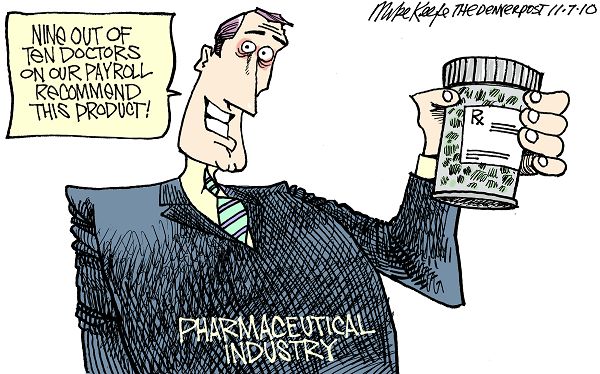Have you ever wondered why it is that pharmaceutical products often cost several times as much in the United States (in some cases hundreds of times as much) then they do in other countries? I’m going to answer that question. I’ll start out showing why pharmaceuticals cost more in the United States, in general, than they do in other countries, and then I will, more briefly, look at insulin in particular.
There are two reasons pharmaceuticals cost more in the United States than they do in other countries. One is that we subsidize the cost of pharmaceuticals for other countries, and the other is that our government has made a joke out of ‘truth in advertising’ laws, which has grossly distorted our pharmaceutical industry.
First, let us look at how the United States subsidizes the pharmaceutical costs of the rest of the world.
To understand this portion of the problem, one needs to understand that there are two kinds of costs that go into any product: fixed costs, and variable costs. Fixed costs do not change when the number of something produced changes. Variable costs do change when the number of something changes.
As an example, the CEO of a door company gets paid whether the door company produces one door, or a million doors. This CEO’s salary is a fixed cost. Conversely, the cost of wood will vary radically depending on the number of doors that are produced. Wood would be a variable cost
It costs, on average, 12 years and $2.7 billion to get a product through the FDA. It also costs billions of dollars to develop a new drug (before seeking FDA approval), and only a handful of the drugs pharmaceutical companies develop ever see the market, which means that the products that do make it to market must cover the R&D, and regulatory burdens, not only for themselves, but also for all of the products that never make it to market.
All of these costs are fixed costs, that do not change whether one pill is produced, or 100 million pills are produced, and though it may cost, say, five cents to make an additional pill (aka the ‘variable cost’), when you spread all the fixed costs, like R&D, across all of the pills expected to be sold during the period a pill is still under patent, the per pill cost is much higher than just the cost of producing another pill.
Throw in single-payer systems, that dominate the industrialized world. These systems negotiate with pharmaceutical companies based only on the variable costs of producing one more pill – completely ignoring all fixed costs. Third world countries can not afford to pay these fixed costs, leaving the United States all alone, as the only nation on Earth from which pharmaceutical companies can recoup fixed costs.
I, personally, have no problem letting poor countries negotiate with pharmaceutical companies based only on variable costs, but countries like Canada, Germany, and England can afford to carry their fair share of the fixed costs, and they should be made to do so. This would increase the cost of pharmaceuticals in these countries, but it would reduce the cost of pharmaceuticals here.
The second reason pharmaceuticals cost so much in the United States is that they are allowed to market directly to consumers, while making a mockery of ‘truth in advertising’ laws.
It was not that long ago that pharmaceutical companies were not allowed to market directly to consumers. Pharmaceuticals are by nature prescribed by doctors, and it was thought that while consumers might be the ones who consume pharmaceuticals, doctors really are the ones best positioned to determine when to use them – which is the whole point in making people need prescriptions to get them.
The pharmaceutical industry lobbied government long and hard to have the rules changed, and today it is perfectly legal for them to advertise directly to consumers. At first pharmaceutical companies had to follow truth in advertising laws that said that their advertisements had to be true, and in fact some advertisements were taken off the air for making claims that could not be supported. In time, big pharma was able to lobby government such that it became OK to say anything that was not false.
That sounds like a small change, but think of the implications. If a pharmaceutical company markets a pill ‘for’ a particular ailment, and it has to be truthful, then that pill had better work, for saying it ‘is taken for’ an ailment implies that it has a positive effect. Change the law such that pharmaceutical companies can say anything that is not expressly false, and suddenly as long as they can get people to take a pill ‘for’ a particular ailment, they can advertise the pill as ‘taken for’ an ailment whether it works or not.
With this change, suddenly all kinds of things were possible. Not only could pharmaceutical companies sell pills ‘for’ ailments that the pills did absolutely nothing for (they also incidentally had the patent code changed so they could extend patents by moving pills into new uses), but suddenly it was also possible to sell a pill “taken to enhance that special part of the male anatomy” even when that pill made no difference to any part of the male anatomy.
Not to stop there, the pharmaceutical companies began to pay doctors to tour the country with new ailments that did not previously exist, that people could take their pills ‘for’. We actually studied this when I was getting my MBA, and we found that pharmaceutical companies made more than half their revenue selling medications that did not work, in the treatment of ailments that did not exist.
Pharmaceutical companies are also protected from litigation when their products harm consumers. As long as they run really small print across the TV screen telling you all of the innumerable ways their products might hurt you, they are protected from you suing them when you are in fact hurt taking a pill that does not work, for an ailment that does not exist.
Allowing pharmaceutical companies to advertise directly to consumers has not directly impacted the cost of legitimate pharmaceuticals, but it has reduced the value of legitimate pharmaceuticals to those companies to the point that legitimate drugs represent less than half the US market. This has radically distorted the market, causing all kinds of problems, including higher costs for legitimate pharmaceuticals.

Insulin is in a somewhat unique situation.
A pharmaceutical company called Humulin developed a new technique for producing insulin, using a process called ‘recombinant DNA technology,’ in which the human gene that produces insulin was combined with bacteria. The bacteria, then, produced insulin.
Prior to Humulin, people received animal-based insulin, and though the newer form of insulin, being human-based, was in some ways superior to the older forms of insulin, animal-based insulins are much, much less expensive to produce.
Humulin was, of course, given a patent for recombinant DNA technology, allowing them to charge enough to recoup the research and development costs associated with this technology. The United States is (as shown above) the only country from which Humulin can recoup those costs, making this newer form of insulin more expensive in the United States than in other countries.
But Humulin was also able to get animal-based insulin removed from the American market, such that only Humulin’s patented insulin was available.
The patent on Humulin’s insulin has recently expired, and as a result, generic versions of this insulin are expected to start hitting the market, but the production costs of this form of insulin are still much higher than are the production costs of animal-based forms of insulin, and as such, the cost of insulin in the United States will remain higher than in other countries, until such a time as animal-based forms of insulin are allowed to re-enter the market.
Those who want to regulate pricing in the pharmaceutical industry, or who want to allow us to purchase pharmaceuticals from other countries (like Canada) are being short-sighted. If the United States stops paying for the research and development costs of new pharmaceuticals, pharmaceutical development will come to a screeching halt.
A better solution would be to negotiate with other countries, to get them to agree to pick up a fair portion of the fixed costs of pharmaceuticals, reducing the burden on the United States, while still allowing those costs to be recouped.
As for the distortions in the market, that’s also easy to fix. We should simply force pharmaceutical companies to follow truth in advertising laws, legitimately. Big pharma would lose half it’s market tomorrow, and the distortions would go away.
We see another, potentially more serious, problem illustrated by insulin: the FDA.
There is a revolving door between big pharma and the FDA, just as there is between the regulators and the regulated in any regulated industry. And frankly, there will always be such a revolving door, for those with the expertise to regulate any given industry will always be the ones in that industry.
The FDA does two things. One is to allow new drugs onto the market, and the other is to either prevent drugs from entering the market, or to take them off market. We can find examples of the FDA taking drugs off the market, or keeping drugs from hitting the market, in which the FDA saved lives. We can also, however, show numerous examples of the FDA keeping helpful drugs off the market, leading to great harm for those who could have taken those drugs, had they been allowed to do so – such as diabetics being forced to take only the most expensive insulin.
I do not blame diabetics for being angry about the high cost of insulin, and I don’t blame people who take other drugs that are more expensive than they should be, for other ailments.
I do blame our pharmaceutical regulatory system, which is entirely broken.
In my opinion, the FDA should be abolished, and so too should the laws protecting pharmaceutical companies from litigation. The FDA has caused more harm than good, and the good that the FDA does do, the threat of tort law could do at least as well.
So there you have it – a full diatribe on the pharmaceutical industry, and all that ails it. Just to recap, I called for three changes: 1) legitimate use of ‘truth in advertising’ laws, 2) the elimination of the FDA, as well as all litigation protections enjoyed by the pharmaceutical industry, and 3) pharmaceutical trade agreements that force other rich countries to share the burden of fixed costs.
Other people may have other solutions, and that’s fine. The primary purpose of this article is not to say that my suggested solutions are the best ones, but to illustrate what the true problems are. We can discuss alternative solutions later – and hopefully from a position of knowledge.




















